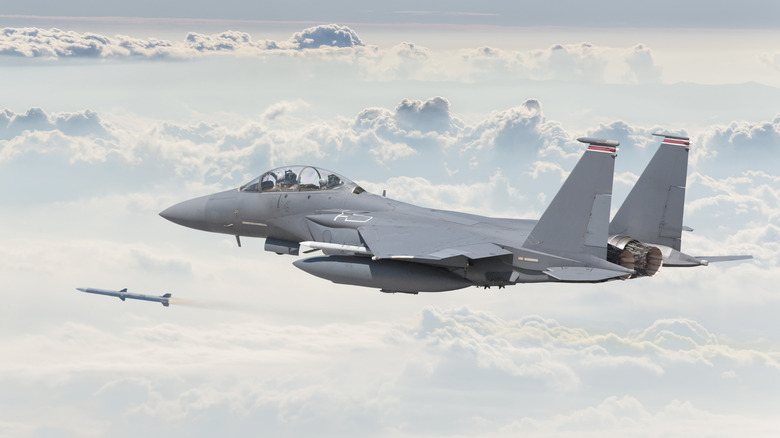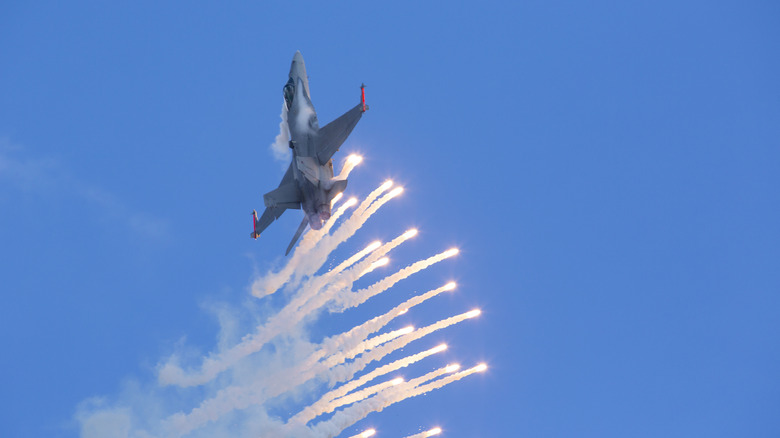How Fighter Pilots Evade Missiles And Live To Tell The Tale
Since World War I, aerial combat has changed significantly. Starting from simple reconnaissance and small-scale dogfights with biplanes, aerial warfare today involves complex air combat tactics with stealth aircraft. Modern air combat is distinguished by its state-of-the-art fighters and its sophisticated weaponry. Missiles are one of the most important armaments for modern fighter jets, because of their effectiveness and accuracy, and in the case of the F-22 Raptor, it is armed with two different types of missiles. Despite this, pilots can still evade missiles through a combination of technology and evasive maneuvers.
Fighter jets have advanced electronics to avoid enemy fire, primarily relying on onboard radar, which serves as an early warning system. With this system, the pilot can identify different threats, including missiles and other aircraft. The way the radar works is that it sends out radio signals that bounce off approaching missiles to identify potential threats. The distance, speed, and trajectory of the missile are then determined by analyzing the reflected signals. Once this information is processed, the pilot can use evasive maneuvers and countermeasures to protect the aircraft.
Tactical maneuvering involves the use of high-G maneuvers, which are dramatic shifts in an aircraft's direction or speed that cause a stronger gravitational pull on the pilot. These movements are used to escape from enemy aircraft and missiles, and include hard turns to steer the fighter away to avoid a radar lock, flying at lower altitudes, and using the split S and Herbst maneuvers. Lastly, flares are one of two fighter jet countermeasures, which are pyrotechnic devices that produce intense heat and lure missiles away, and chaff, which are tiny strips of aluminum or metallic fiberglass that bounce back radar signals that confuse missile targeting sensors.
Using skill and technology to survive
An important capability of some fighter jets is stealth, which is another vital element used by fighter pilots to avoid missiles. Considered as a passive countermeasure, stealth focuses on decreasing an aircraft's detectability by limiting its radar cross-section, infrared signature, and other sources of detection instead of actively luring away or obstructing approaching missiles. Lastly, certain fighter jets like the F-35 Lightning are equipped with AESA radar jamming technology that can disrupt enemy targeting systems.
To maintain readiness for combat, fighter jet pilots are required to undergo intensive training for their particular aircraft, including its weapons and equipment, and are educated in tactics and maneuvers for a range of combat scenarios. Alongside this, pilots are equipped with personal protective equipment that includes a helmet with a visor and oxygen mask, a G-suit, specialized boots, and a fire-resistant Nomex flight suit. Other equipment pilots use is a survival vest, which comes with communication and survival tools, and night vision goggles, which are intended to reduce the associated risks during aerial combat, including high G-forces and high-speed flight.
For fighter planes to survive and complete combat missions, aircraft mastery and countermeasures are vital. As a series of defenses that shield pilots from hazards like radar detection and missiles, countermeasures enable aircraft to avoid or mislead adversary systems, which all contribute to the greater survivability of the aircraft and its pilots. Due to the continuous progress of missile technology, countermeasures like directed energy weapons, and artificial intelligence are also being studied and developed for fighter jets as a possible addition to their defensive capabilities.

